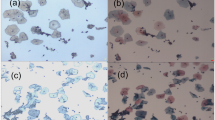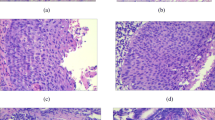Abstract
Infrared (IR) spectroscopic imaging coupled with microscopy has been used to investigate thin sections of cervix uteri encompassing normal tissue, precancerous structures, and squamous cell carcinoma. Methods for unsupervised distinction of tissue types based on IR spectroscopy were developed. One-hundred and twenty-two images of cervical tissue were recorded by an FTIR spectrometer with a 64×64 focal plane array detector. The 499,712 IR spectra obtained were grouped by an approach which used fuzzy C-means clustering followed by hierarchical cluster analysis. The resulting false color maps were correlated with the morphological characteristics of an adjacent section of hematoxylin and eosin-stained tissue. In the first step, cervical stroma, epithelium, inflammation, blood vessels, and mucus could be distinguished in IR images by analysis of the spectral fingerprint region (950–1480 cm−1). In the second step, analysis in the spectral window 1420–1480 cm−1 enables, for the first time, IR spectroscopic distinction between the basal layer, dysplastic lesions and squamous cell carcinoma within a particular sample. The joint application of IR microspectroscopic imaging and multivariate spectral processing combines diffraction-limited lateral optical resolution on the single cell level with highly specific and sensitive spectral classification on the molecular level. Compared with previous reports our approach constitutes a significant progress in the development of optical molecular spectroscopic techniques toward an additional diagnostic tool for the early histopathological characterization of cervical cancer.





Similar content being viewed by others
Abbreviations
- IR:
-
Infrared
- Pap:
-
Papanicolaou
- H&E:
-
Hematoxylin and eosin
- FPA:
-
Focal plane array
- FT:
-
Fourier transform
- FCM:
-
Fuzzy C-means
- HCA:
-
Hierarchical cluster analysis
References
Dukor RK (2002) In: Chalmers JM, Griffiths PR (eds.) Handbook of Vibrational Spectroscopy. John Wiley and Sons Ltd., New York 3335–3361
Wood BR, Chiriboga L, Yee H, Quinn MA, McNaughton D, Diem M (2004) Gynecol Oncol 93:59–68
Wong PTT, Lacelle S, Fung Kee Fung M, Sentermann M, Mikhael NZ (1995) Biospectroscopy 1:357–364
Mordechai S, Sahu RK, Hammody Z, Mark S, Kantarovich K, Guterman H, Podshyvalov A, Goldstein J, Argov S (2004) J Microsc 215:86–91
Chang JI, Huang YB, Wu PC, Chen CC, Huang SC, Tsai YH (2003) Gynecol Oncol 91:577–583
Chiriboga L, Xie P, Yee H, Zarou D, Zakim D, Diem M (1998) Cell Mol Biol 44:219–229
Scully RE, Bonfiglio TA, Kurman RJ, Silverberg SG, Wilkinson EJ (1994) WHO—Histological typing of female genital tract tumors. Springer, Berlin Heidelberg New York
Zaino RJ, Ward S, Delgado G, Bundy B, Gore H, Fetter G, Ganjei P, Frauenhoffer E (1992) Cancer 69:1750–1758
Tsuda H, Mikami Y, Kaku T, Akiyama F, Hasegawa T, Okada S, Hayashi I, Kasamatsu T (2003) Pathol Int 53:440–449
Dumas P, Jamin N, Teillaud JL, Miller LM, Beccard B (2004) Faraday Discuss 126:289–302
Lewis EN, Treado PJ, Reeder RC, Story GM, Dowrey AE, Marcott C, Levin IW (1995) Anal Chem 67:3377–3381
Kidder LH, Kalasinsky VF, Luke JL, Levin IW, Lewis EN (1997) Nature Medicine 3:235–237
Potter K, Kidder LH, Levin IW, Lewis EN, Spencer RGS (2001) Arthritis and Rheumatism 44:846–855
Camacho NP, West P, Torzilli PA, Mendelsohn R (2001) Biopolymers 62:1–8
Ou-Yang H, Paschalis EP, Mayo WE, Boskey AL, Mendelsohn R (2001) J Bone Miner Res 16:893-900
Fabian H, Lasch P, Boese M, Haensch W (2002) Biopolymers 67:354–357
Krafft C, Salzer R, Soff G, Meyer-Hermann M (2005) Cytometry A 64A:53–61
Fernandez DC, Bhargava R, Hewitt SM, Levin IW (2005) Nat Biotech 23:469–474
Romeo M, Burden FR, Wood BR, Quinn MA, Tait B, McNaughton D (1998) Cell Mol Biol 44:179–187
Cohenford MA, Godwin TA, Cahn F, Bhandare P, Caputo TA, Rigas B (1997) Gynecol Oncol 66:59–65
Shaw RA, Guijon FB, Paraskevas M, Ying SL, Mantsch HH (1999) Anal Quant Cytol Histol 21:292–302
Lasch P, Naumann D (1998) Cell Mol Biol 44:189–202
Horn LC, Fischer U, Bilek K (2001) Zentralbl Gynakol 123:255–265
Tran TN, Wehrens R, Buydens LMC (2005) Chem Intell Lab Systems 77:3–17
Lasch P, Haensch W, Naumann D, Diem M (2004) Biochim Biophys Acta 1688:176–186
Wood BR, Quinn MA, Tait B, Romeo M (1998) Biospectroscopy 4:75–91
Chiriboga L, Xie P, Yee H, Vigorita V, Zarou D, Zakim D, Diem M (1998) Biospectroscopy 4:47–53
Romeo M, Wood BR, McNaughton D (2002) Vib Spectrosc 28:167–175
Boydston-White S, Gopen T, Houser S, Bargonetti J, Diem M (1999) Biospectroscopy 5:219–227
Diem M, Boydston-White S, Chiriboga L (1999) Applied Spectroscopy 53:148A–161A
Hanahan D, Weinberg RA (2000) Cell 100:57–70
Lasch P, Naumann D (1998) Cell Mol Biol 44:189–202
Acknowledgement
W. Steller and C. Krafft are supported by the Volkswagen Foundation within the project “Molecular Endospectroscopy” of the program “Junior Research Groups at Universities”. U.-D. Braumann and H. Binder acknowledge financial support of the Deutsche Forschungsgemeinschaft under grant no. BIZ 6/1-2.
Author information
Authors and Affiliations
Corresponding author
Rights and permissions
About this article
Cite this article
Steller, W., Einenkel, J., Horn, LC. et al. Delimitation of squamous cell cervical carcinoma using infrared microspectroscopic imaging. Anal Bioanal Chem 384, 145–154 (2006). https://doi.org/10.1007/s00216-005-0124-4
Received:
Revised:
Accepted:
Published:
Issue Date:
DOI: https://doi.org/10.1007/s00216-005-0124-4




